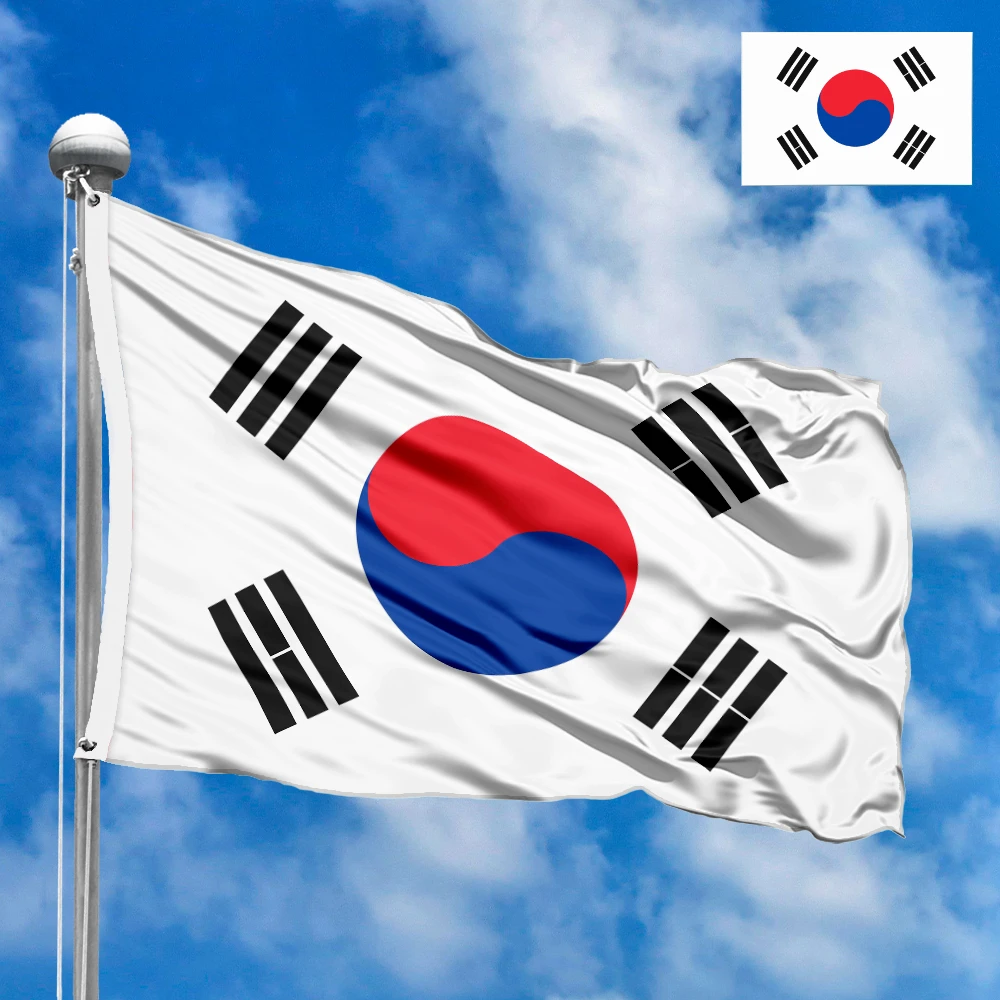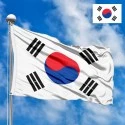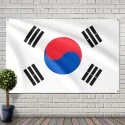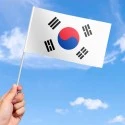The national flag of South Korea, universally known as the Taegeukgi (태극기), is a profound embodiment of the nation's philosophical heritage, its journey through history, and the enduring aspirations of its people. Far more than a mere national symbol, it represents the harmonious balance of the universe, the resilience of the Korean spirit, and the pursuit of peace and prosperity. Its distinctive design makes it one of the most unique and recognizable flags in the world.
Design and Dimensions
The Taegeukgi features a simple yet powerful design. It consists of a white rectangular background, upon which a central Taegeuk symbol (often translated as "Great Polarity" or "Supreme Ultimate") is prominently displayed. This symbol is a circle divided into two interlocking halves: the upper part is red, and the lower part is blue. Surrounding this central motif, in each of the four corners of the flag, are four black trigrams (gwae). The standard proportions for the flag are typically 2:3 (height to width), ensuring a balanced and aesthetically pleasing representation of its intricate elements.
Symbolism of the Colors and Elements
Each element of the Taegeukgi is rich with philosophical and cultural symbolism:
-
White Background: The pristine white field represents purity, peace, and integrity. Historically, white was the traditional color of clothing worn by the Korean people, reflecting their historical desire for peace and their inherent love for simplicity and harmony. It signifies the innate honesty and straightforwardness of the nation.
-
Taegeuk Symbol: The central red and blue Taegeuk embodies the origin of all things in the universe. It represents the concept of yin and yang (eumyang in Korean), the cosmic forces that are in perfect balance and continuous motion.
-
The red (Yang) portion symbolizes the active, positive cosmic forces: warmth, light, life, creation, and masculinity.
-
The blue (Yin) portion signifies the passive, negative cosmic forces: coldness, darkness, death, receptivity, and femininity. Together, they illustrate the constant interplay and harmony between opposing forces, fostering unity and balance within nature and society.
-
Four Black Trigrams (Gwae): The four distinct black trigrams in the corners of the flag are derived from the ancient Chinese text, the I Ching (Book of Changes), and represent the fundamental elements and directions. They also symbolize the principles of movement and harmony, further complementing the Taegeuk symbol:
-
☰ Geon (건) – Top-left: Composed of three solid lines, it symbolizes Heaven, sky, justice, spring, and the East. It embodies strength, creativity, and the heavens.
-
☷ Gon (곤) – Bottom-right: Composed of three broken lines, it symbolizes Earth, vitality, summer, and the West. It represents receptivity, nurturing, and the ground.
-
☵ Gam (감) – Top-right: Consisting of a solid line between two broken lines, it symbolizes Water, wisdom, winter, and the North. It denotes fluidity, danger, and introspection.
-
☲ Ri (리) – Bottom-left: Comprising a broken line between two solid lines, it symbolizes Fire, fruition, autumn, and the South. It represents clarity, enlightenment, and warmth. These trigrams, placed in specific corners, indicate continuous development and interaction between the cosmic elements, representing the nation's commitment to balanced progress.
Creation and Adoption
The history of the Taegeukgi dates back to the late Joseon Dynasty. Its origins are often attributed to Park Yeong-hyo (Bak Yeong-hyo), a Korean diplomat, who in 1882 was tasked with designing a national flag for diplomatic missions to Japan. He adapted existing designs that featured the Taegeuk symbol, adding the four trigrams to create a unique emblem that encapsulated Korean philosophy. This initial version was slightly refined over the subsequent years.
The Taegeukgi became the official flag of the Korean Empire (1897-1910). During the period of Japanese colonial rule (1910-1945), the display of the Taegeukgi was suppressed, but it continued to serve as a powerful symbol of Korean independence and resistance among patriots at home and abroad. After Korea's liberation in 1945 and the establishment of the Republic of Korea (South Korea) government in 1948, the Taegeukgi was readopted. Its current design specifications were formally codified on October 15, 1949, by the South Korean government, cementing its place as the enduring national flag.
Significance for the Inhabitants
For the people of South Korea, the Taegeukgi is a profound emblem of their national identity, cultural heritage, and enduring resilience. It represents their aspiration for a peaceful and harmonious future, built upon principles of balance, progress, and justice. The white background embodies their desire for peace and purity, while the Taegeuk symbol reminds them of the interconnectedness of all things and the importance of harmony in diversity.
Displayed proudly during national holidays, sporting events, and in schools, the flag evokes a strong sense of patriotism and unity. It is a testament to the nation's ability to overcome adversity, from colonial rule to the Korean War, and to emerge as a vibrant, democratic, and technologically advanced society. For many Koreans, the Taegeukgi is not just a flag; it is a visual representation of their spirit, their history, and their collective dreams for the future.
Interesting Facts
-
Taegeukgi's Name: The flag is almost exclusively referred to by its Korean name, Taegeukgi (태극기), which directly translates to "Taegeuk flag," emphasizing the central symbol.
-
Philosophical Depth: Unlike many national flags, the Taegeukgi's design is not primarily historical or military, but deeply rooted in East Asian philosophy, drawing heavily from the I Ching and Taoist concepts of yin and yang.
-
Symbol of Resistance: During the Japanese colonial period, owning or displaying the Taegeukgi was considered a subversive act and was severely punished. This history imbues the flag with a powerful legacy of resistance and the struggle for independence.
-
The Unification Flag: While South Korea has its own Taegeukgi, a different "Korean Unification Flag" (a white flag with a blue Korean Peninsula outline) is sometimes used in international sporting events where both Koreas participate together, symbolizing aspirations for future reunification.
-
Specific Trigram Meanings: The precise arrangement of the trigrams is not random; they are placed to represent a cyclical flow of elements and directions, reinforcing the flag's message of continuous harmony and balance.
In the demonstration images, full-size flags are shown with proportions of 2:3, and hand-held flags with proportions of 1:2.







 Waving flag
Waving flag
 Sizes:
Sizes:
 Round flag
Round flag
 Sizes:
Sizes:
 Rectangular flag 2:3
Rectangular flag 2:3
 Sizes:
Sizes: